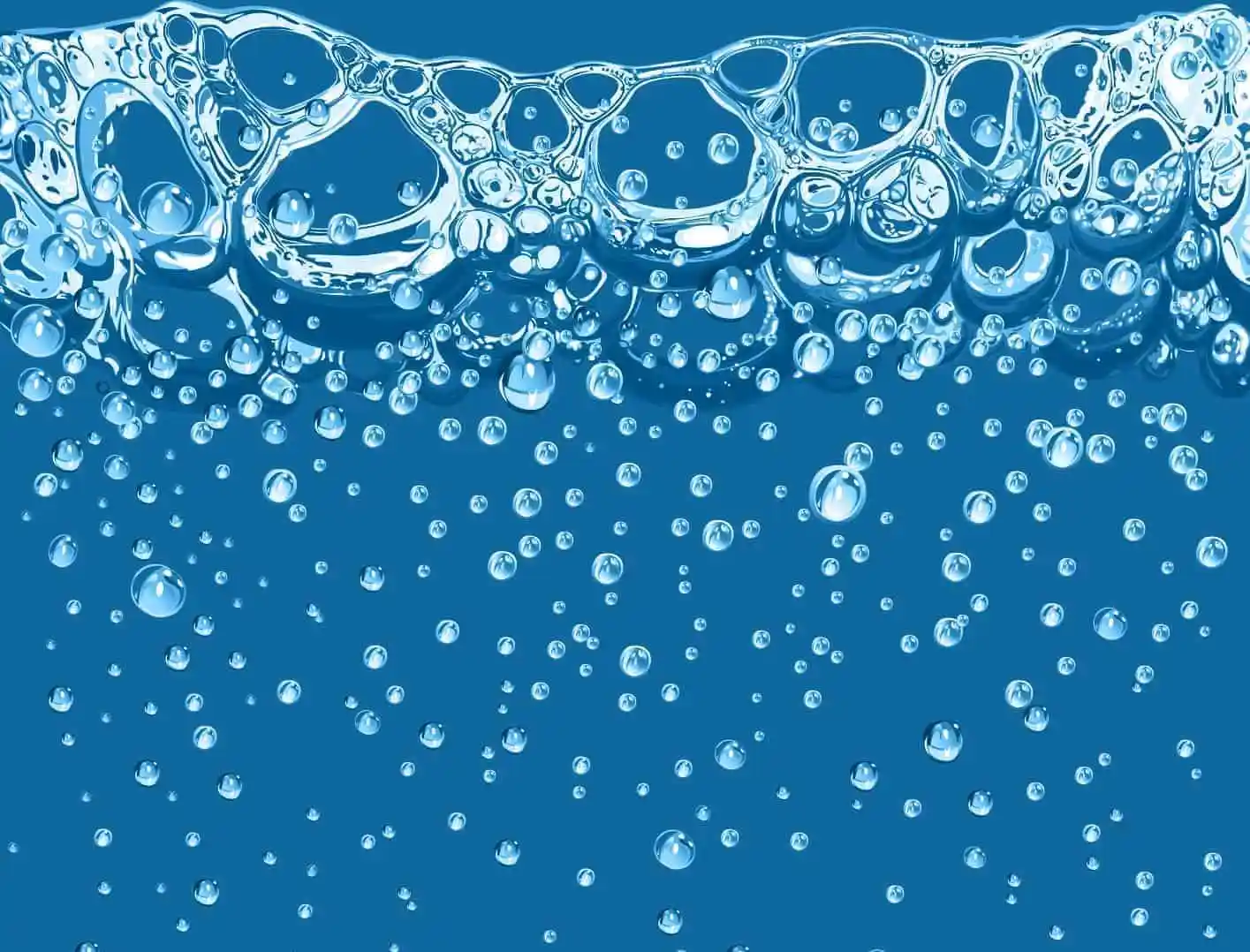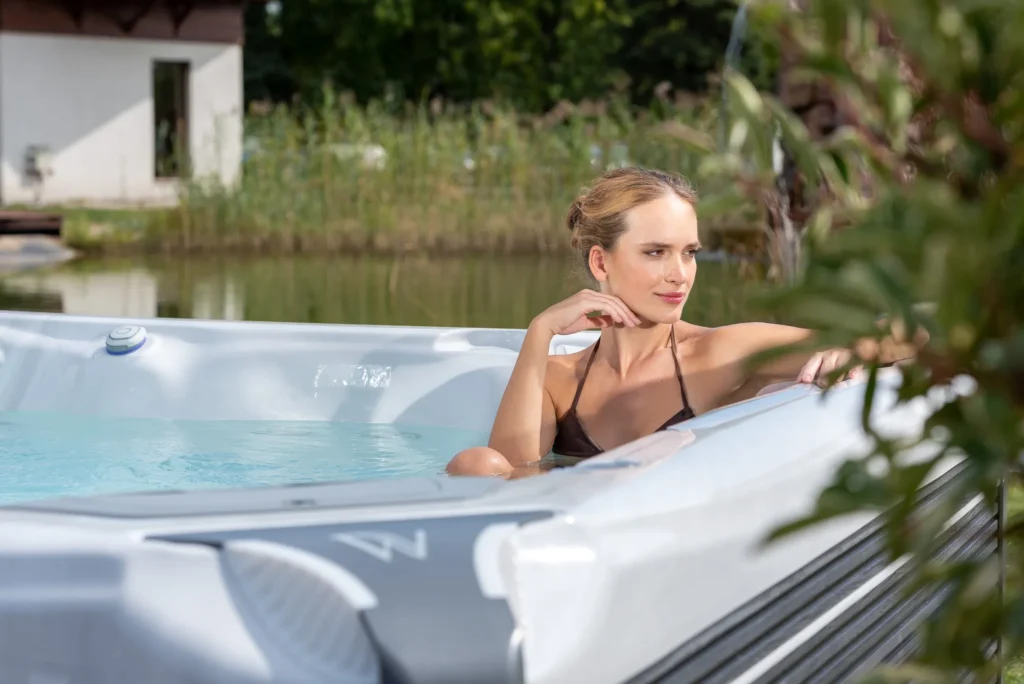There are pros and cons of having salt water Vs. chlorine hot tubs. This article…

Can You Use Salt Water in a Hot Tub? The Ultimate Guide for 2025
Discover if salt water hot tubs are worth the hype. Learn about costs, benefits, maintenance requirements and how to convert your existing tub.
Thinking about switching to a salt water hot tub? You’re not alone. Many hot tub owners wonder if salt water systems are actually better than traditional chlorine options. After all, nobody wants to soak in a chemical soup, right?
In this article, we’ll cover everything you need to know about salt water hot tubs:
- How salt water systems actually work (spoiler: they still produce chlorine!)
- The real benefits and drawbacks to consider before making the switch
- Practical advice on converting your existing hot tub to a salt water system
Can You Use Salt Water in a Hot Tub? TL;DR
Yes, you can absolutely use salt water in a hot tub, but it’s not as simple as pouring in sea salt and calling it a day. Modern salt water hot tubs use specialized salt chlorine generators that convert sodium chloride into chlorine through electrolysis—giving you the benefits of gentler water that’s softer on skin without the harsh chemical feel, while still maintaining proper sanitation.
However, there are crucial factors to consider including higher upfront costs ($500-$2,000 for the system), potential corrosion risks to metal components, and specific maintenance requirements that differ from traditional systems. It’s a popular option for those with sensitive skin, but definitely requires understanding the full picture before making the switch.

Understanding Salt Water Hot Tub Systems
What Exactly Is a Salt Water Hot Tub?
Contrary to popular opinion, a salt water hot tub isn’t exactly like soaking in ocean water. The salt concentration is much lower (around 1,500-2,000 parts per million compared to the ocean’s 35,000 ppm). This means the hot tub water doesn’t feel salty or leave a sticky residue on your skin.
Here’s the key difference: instead of manually adding chlorine to sanitize the water, you add sodium chloride (salt) to the water. The system then uses electrolysis to convert that salt into chlorine as needed. It’s still a chlorine system—just with a different delivery method.
How Salt Water Systems Generate Chlorine
The process happens in what’s called a salt chlorine generator or chlorinator. When you add sodium chloride to your hot tub water, the water passes through this salt cell where a low-voltage electrical current breaks the salt molecules apart. This electrolysis process converts the salt into hypochlorous acid—the same sanitizing agent found in traditional chlorine.
The chlorine generation happens continuously in small amounts, maintaining a steady, lower level of chlorine rather than the peaks and valleys you get with manual chlorine addition. The system essentially recycles the salt, as the chlorine eventually reverts back to salt after it’s done its sanitizing job.
The Benefits of Salt Water Hot Tubs
Gentler on Skin and Eyes
One of the worst parts of hot tubbing is that strong chemical smell, and the irritated eyes and dry skin those chemicals can lead to afterward. Salt water systems fix this problem by maintaining a lower, more consistent chlorine level than traditional systems, which means less irritation.
Plus, the salt itself makes the hot tub water feel softer against your skin. Many people with sensitive skin find salt water systems much more comfortable.
Reduced Chemical Exposure
While salt water hot tubs still use chlorine to sanitize, your exposure to harsh chemicals is typically reduced. You’re not handling concentrated chlorine products, which means:
- No more strong chemical smell
- Less storage of potentially dangerous chemical additives
- Reduced risk of skin contact with concentrated chlorine chemicals
Natural Feel and Experience
The water in a salt water hot tub has a silky, soft quality that many users describe as more luxurious than traditionally chlorinated water. Some users also report that the hot tub water stays cleaner longer, though this depends on many factors including usage and maintenance.
Potential Drawbacks of Salt Water Hot Tubs

Initial Cost Considerations
Salt water systems aren’t cheap. The initial investment for a salt chlorine generator typically ranges from $500 to $2,000, depending on the brand and your hot tub size. This is significantly more than the startup costs for a traditional chlorine system.
While manufacturers often claim you’ll save money in the long run on chemicals, you’ll need to use the system for quite a while before reaching that break-even point.
Maintenance Requirements
Salt water systems aren’t maintenance-free—far from it. They require different care than traditional systems:
- The salt cell needs regular cleaning (typically every 3-4 months)
- You’ll still need to monitor and adjust pH, alkalinity, and calcium hardness
- Salt levels need checking and adjustment periodically
- Salt cells have a limited lifespan (usually 2-5 years) and replacement isn’t cheap
Equipment Longevity Concerns
Salt can be corrosive to certain hot tub components over time. Metal components like heaters, rails, and internal metal parts may deteriorate faster when exposed to salt water.
Some manufacturers void warranties if you install an aftermarket salt system, so check your warranty details before converting an existing tub. Higher-end hot tubs often include components specifically designed to withstand salt systems.
Converting an Existing Hot Tub to Salt Water
Compatibility Factors to Consider
Before rushing to convert your existing hot tub, you need to make sure it can handle a salt water system. Check these compatibility factors:
Age and Condition of Your Hot Tub Components
Older hot tubs may not fare well with the increased salinity that comes with a saltwater system. If your hot tub is more than 8–10 years old, you’ll want to thoroughly inspect the condition of internal components such as pumps, jets, and seals.
Materials Used in Construction
Salt water systems are generally gentle on skin and eyes, but not always on metals. If your hot tub has metal parts—especially in heaters, jets, or piping—you’ll need to confirm that they’re made of corrosion-resistant materials like titanium or high-grade stainless steel. Cheaper metals or components not rated for salt exposure may corrode over time, leading to leaks or failures.
Warranty Considerations
This is a big one: converting to a salt water system can sometimes void the manufacturer’s warranty. Most hot tub warranties have very specific clauses about what types of sanitizing systems are approved. If your unit is still under warranty, read the fine print or contact the manufacturer directly to confirm whether a salt system will be covered. It’s better to be safe than stuck with an expensive repair bill that isn’t reimbursed.
Electronic Controls Compatibility
Salt water chlorinators require connection to your hot tub’s control system, and not all tubs are electronically compatible. Some hot tubs may require additional adapters or even control system upgrades to integrate properly with a chlorinator. Make sure your tub has the appropriate ports, voltage support, and digital interface to accommodate the new equipment without risk of electrical issues.
Space Requirements for the Chlorinator
Unlike standard chlorine or bromine floaters, saltwater chlorinators need to be physically installed within your hot tub system. This often includes a cell, control box, and sometimes extra plumbing. If space is limited in or around your hot tub’s cabinet, you may find installation difficult—or even impossible—without significant modification.
Step-by-Step Conversion Process
The process of converting your hot tub to a salt water system isn’t overly complicated—but it does require careful attention to detail to ensure your system functions properly and safely.
Drain and Thoroughly Clean Your Hot Tub
Before installing any new equipment, you’ll need to start with a fresh slate. Drain all the water from your hot tub, including any water trapped in jets or plumbing lines if possible. Once drained, give the shell a deep clean to remove any lingering debris, scale, or chemical residues that could interfere with your new system.
Install the Salt Chlorine Generator
The core of your new system is the salt chlorine generator, also known as a salt cell. This device converts dissolved salt into chlorine through a process called electrolysis. Depending on the model and your spa’s design, installation may involve placing a cell directly into the plumbing line or submerging it in the spa water, as well as mounting a control panel near your hot tub. Electrical wiring is also required, so if you’re not comfortable with minor electrical work, this is where many hot tub owners choose to bring in a professional installer.
Add the Appropriate Amount of Sodium Chloride (Salt)
Once the generator is in place, it’s time to add salt. You’ll need high-purity, additive-free sodium chloride—usually labeled as pool or spa-grade salt. The amount required will depend on your hot tub’s water capacity and the manufacturer’s recommendations, but it typically falls within the range of 2,000 to 3,000 ppm (parts per million). Spread the salt evenly into the water, then turn on the circulation system to help it dissolve completely.
Balance Your Water Chemistry
Salt systems are most effective when your water chemistry is properly balanced. This includes adjusting pH, alkalinity, calcium hardness, and stabilizer (cyanuric acid, if recommended).
Unbalanced water can not only reduce the effectiveness of the chlorinator but also damage hot tub components over time. Use a reliable water testing kit or take a water sample to a local spa retailer to make sure everything is within the correct ranges before moving on.
Run the System
With everything in place and your salt fully dissolved, you can now activate the salt chlorine generator. Allow the system to run according to the manufacturer’s instructions—this usually means turning on the circulation pump and letting the chlorinator produce chlorine continuously or at scheduled intervals. Keep in mind that it may take several hours for the chlorine levels to build up to the proper range.
Test and Adjust Chlorine Levels
Once the system has been running for a while, use test strips or a digital water testing kit to measure your free chlorine levels. You want to aim for a range between 1–3 ppm for safe and effective sanitation. If the levels are too low or too high, adjust the chlorinator’s output accordingly. It may take a few days of monitoring and tweaking to find the right setting for your spa usage.
Salt Water vs. Traditional Chlorine Systems: A Comparison
Water Quality and Feel
When comparing water quality between salt and traditional systems, there are noticeable differences:
| Salt Water Systems | Traditional Chlorine Systems |
| Silky, soft water feel | Sometimes harsher water feel |
| Consistent chlorine levels | Fluctuating chlorine levels |
| Less noticeable chemical smell | Stronger chemical odor possible |
| Less eye and skin irritation | More potential for irritation |
Maintenance Time and Effort
| Salt Water Systems | Traditional Chlorine Systems |
| Less frequent chemical additions | Regular (often weekly) chemical additions |
| Regular salt cell cleaning | More frequent water testing |
| Periodic salt levels checks | Occasional shock treatments |
| Cell replacement every 2-5 years | No special component maintenance |
Long-Term Cost Analysis
Salt Water System (5-year estimate): $1,800-$3,500
- Initial system cost: $1,000-$2,000
- Sodium chloride: $20-40 per year
- Cell replacement: $300-600 every 3-5 years
- Water balance chemicals: $100-200 per year
Traditional Chlorine System (5-year estimate): $2,050-$4,000
- Initial supplies: $50-100
- Chlorine products: $200-400 per year
- Shock treatments: $100-200 per year
- Water balance chemicals: $100-200 per year
While salt systems can save money over time, the break-even point is typically 2-3 years into ownership.
Common Misconceptions About Salt Water Hot Tubs
“Salt Water Tubs Are Chlorine-Free”
We want to be crystal be clear: salt water hot tubs still use chlorine to sanitize the water. The difference is in how the chlorine is produced. Rather than adding chlorine directly, salt systems generate chlorine through the electrolysis process.
If you’re looking for a truly chlorine-free alternative, you’ll need to explore other options like mineral purifiers, ozone generators, or UV sanitizers (though most of these still require some chlorine backup).
“Salt Water Systems Require No Maintenance”
While you’ll spend less time adding chemicals, you’ll still need to:
- Test water chemistry regularly
- Clean the salt cell periodically
- Check and adjust salt levels
- Balance pH, alkalinity, and calcium hardness
- Replace the salt chlorine generator cell every few years
Salt systems require different maintenance, not necessarily less maintenance.
Best Practices for Salt Water Hot Tub Maintenance
Regular Testing and Balancing
Proper water chemistry remains essential with salt water systems. Here’s what you need to monitor:
- Free chlorine levels – Aim for 1-3 ppm
- pH levels – Keep between 7.2-7.6 (salt systems tend to raise pH over time)
- Total alkalinity – Maintain 80-120 ppm
- Calcium hardness – Keep at 150-250 ppm
- Salt levels – Follow manufacturer recommendations (typically 1,500-2,000 ppm)
Testing at least weekly helps catch problems before they become serious.
Salt Cell Cleaning and Care
The salt cell is the heart of your salt chlorine generator, and keeping it clean is crucial:
- Turn off power to the system before cleaning
- Remove the cell according to manufacturer instructions
- Inspect for calcium buildup
- Use a cell cleaning solution or a diluted acid solution
- Rinse thoroughly before reinstalling
Most manufacturers recommend cleaning the cell every 3-4 months.
Is a Salt Water Hot Tub Right for You?
When deciding if a salt water hot tub fits your lifestyle, consider:
- How often you use your hot tub
- Whether you have sensitive skin or react to chlorine
- Your comfort with periodic maintenance tasks
- Your budget for upfront costs vs. ongoing expenses
- How important water feel is to your experience
If you use your hot tub several times weekly and prioritize water comfort, a salt system might be worth the investment. For occasional users, the higher upfront cost may be harder to justify.
Environmental Considerations
Salt water systems require electricity to power the electrolysis process, though the impact on your energy bill is usually minimal.
From an environmental perspective, salt water systems have both advantages (reduced packaging waste, lower chemical production) and disadvantages (salt cell manufacturing and disposal, increased electricity usage).
When draining a salt water hot tub, consider where the water will go. The salt concentration isn’t high enough to harm most plants in small amounts, but regular draining in the same area could affect soil quality over time.
Conclusion: Making an Informed Decision
Salt water hot tubs can be an excellent choice for many hot tub owners, particularly those who:
- Value water comfort and feel
- Have sensitivity to traditional chlorine systems
- Are willing to invest upfront for potential long-term benefits
- Don’t mind periodic maintenance tasks
However, they’re not perfect for everyone. The higher initial cost, potential equipment concerns, and specific maintenance requirements make them less suitable for some situations.
Whether you choose salt or traditional sanitation, proper hot tub water treatment remains the key to a clean, enjoyable hot tub experience.
Frequently Asked Questions
What is a Salt Water Hot Tub?
A salt water hot tub uses a chlorine generator to convert sodium chloride (salt) into sanitizer through electrolysis. It’s not like ocean water—the salt content is much lower at about 1,500-2,000 ppm, and the water feels softer than traditionally chlorinated spas.
How Does a Salt Water Hot Tub Work?
The system uses electrolysis to convert dissolved salt into chlorine. Water passes through a salt cell containing metal plates charged with low-voltage electricity, which breaks salt molecules apart to create hypochlorous acid—the same sanitizing agent found in traditional chlorine but produced continuously in smaller amounts.
Are Salt Water Hot Tubs Chlorine-Free?
No! This is a common misconception. Salt water hot tubs still use chlorine to sanitize water—they just produce it differently through electrolysis rather than requiring you to add chlorine products manually. The end sanitizing agent is identical to traditional systems.
Does salt water damage a hot tub?
Salt water can potentially accelerate corrosion on certain hot tub components, particularly metal parts like heaters and internal components. Modern hot tubs designed specifically for salt systems use corrosion-resistant materials, but older models may experience issues over time.
Can you turn a regular hot tub into a saltwater hot tub?
Yes, most hot tubs can be converted by installing a salt chlorine generator system. However, not all tubs are equally suitable—older tubs with many metal components may face corrosion issues. Always check your warranty first, as some manufacturers void coverage if aftermarket salt systems are installed.
What do I need for a salt water hot tub?
You’ll need a salt chlorine generator (priced $500-$2,000), salt formulated for spas (not table salt), water testing equipment to monitor salt levels and water chemistry, and cleaning supplies for periodic maintenance of the salt cell. It’s also helpful to have corrosion-resistant fixtures if possible.

Ready to purchase a hot tub in NC?
Call us at 888-884-3742 or fill out the form below to get in touch with a member or our team.
Richard Horvath
Richard has been in the hot tub & spa industry for years. As a long hot tub & swim spa owner himself, Richard has a passion for helping homeowners create their dream backyard.



